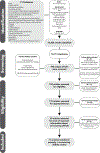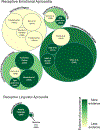The Company Prosodic Deficits Keep Following Right Hemisphere Stroke: A Systematic Review
- PMID: 34989666
- PMCID: PMC9256864
- DOI: 10.1017/S1355617721001302
The Company Prosodic Deficits Keep Following Right Hemisphere Stroke: A Systematic Review
Abstract
Objectives: The aim of this systematic review was to identify the presence and nature of relationships between specific forms of aprosodia (i.e., expressive and receptive emotional and linguistic prosodic deficits) and other cognitive-communication deficits and disorders in individuals with right hemisphere damage (RHD) due to stroke.
Methods: One hundred and ninety articles from 1970 to February 2020 investigating receptive and expressive prosody in patients with relatively focal right hemisphere brain damage were identified via database searches.
Results: Fourteen articles were identified that met inclusion criteria, passed quality reviews, and included sufficient information about prosody and potential co-occurring deficits. Twelve articles investigated receptive emotional aprosodia, and two articles investigated receptive linguistic aprosodia. Across the included studies, receptive emotional prosody was not systematically associated with hemispatial neglect, but did co-occur with deficits in emotional facial recognition, interpersonal interactions, or emotional semantics. Receptive linguistic processing was reported to co-occur with amusia and hemispatial neglect. No studies were found that investigated the co-occurrence of expressive emotional or linguistic prosodic deficits with other cognitive-communication impairments.
Conclusions: This systematic review revealed significant gaps in the research literature regarding the co-occurrence of common right hemisphere disorders with prosodic deficits. More rigorous empirical inquiry is required to identify specific patient profiles based on clusters of deficits associated with right hemisphere stroke. Future research may determine whether the co-occurrences identified are due to shared cognitive-linguistic processes, and may inform the development of evidence-based assessment and treatment recommendations for individuals with cognitive-communication deficits subsequent to RHD.
Keywords: Right hemisphere damage (RHD); aprosodia; cognitive communication disorders; emotional prosody; linguistic prosody; stroke.
Conflict of interest statement
CONFLICT OF INTEREST
The authors have nothing to disclose.
Figures


References
-
- Angeleri R, Bosco FM, Gabbatore I, Bara BG, & Sacco K. (2012). Assessment battery for communication (ABaCo): Normative data. Behavior Research Methods, 44(3), 845–861. - PubMed
-
- Balan A. & Gandour J. (1999). Effect of sentence length on the production of linguistic stress by left-and right-hemisphere-damaged patients. Brain and Language, 67(2), 73–94. - PubMed
-
- Baum SR & Pell MD (1997). Production of affective and linguistic prosody by brain-damaged patients. Aphasiology, 11(2), 177–198.
-
- Bélanger N, Baum SR, & Titone D. (2009). Use of prosodic cues in the production of idiomatic and literal sentences by individuals with right-and left-hemisphere damage. Brain and Language, 110(1), 38–42. - PubMed
Publication types
MeSH terms
Grants and funding
LinkOut - more resources
Full Text Sources
Medical
Miscellaneous

